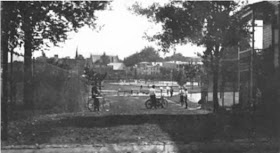 A Spring, 1959 photo of two students in the 1959 8th grade class: Seth McQuillan and Judy Delph (photo courtesy of Seth McQuillan)
A Spring, 1959 photo of two students in the 1959 8th grade class: Seth McQuillan and Judy Delph (photo courtesy of Seth McQuillan)

W. (William) George Hayward had been principal 1952 to 1955. Paul (Paul Alfred) Shelly was principal from 1955-60. Rev. Clark Van Auken was the minister for Park Avenue Methodist Church at the corner of Park Ave. and Grove St. (promotion exercises documents courtesy of Seth McQuillan, a member of the 1959 class)
Three photo sections above courtesy of Seth McQuillan
Above:1959 graduation photo (right and left sides of original) above courtesy of Mary Keogh, a member of the class
Below: the two halves stitched back together using software ("stitching" courtesy of George Morgan)
1st row: Janice Korten, Mary Ann Griesinger, Maxine Gilchrist, Melinda Rudzinski, Lorraine Tate, Patricia LaBrew, Sheila Alston, ? , Betty Dunston, Sandra Grief, Roberta Smith, Carole Sullivan, Judith Delph, Mary Keogh, Patricia Burke, Jean Anderson, Emma Bindi, Anna Janulis, Sandra Thomas, Claudine Cummings, Joyce Hines, Carol Nixon, Francine Watson;
2nd row: ?, Stephen Ferguson, Edward Johnson, Lawrence Davis, Donald Critchett, Peter Cino, Richard Reaves, James Pendorf, Frank Pendorf, George Alger, Seth McQuillan, Salvatore Meola, Michael Ehert, Steve Lowry, Gabriel Petrocelli, William Hoffman, Oreste Avallone (Orey), David Delph, William Abele;
3rd row: Anthony Badalamenti, Kenneth Ruth, Alex Nastasi, Robert ?, Douglas Herig, Robert Gibson, Steve Polychrony, William Gerulsky, James Stark, ? , Thomas Parciak, Paul Pearsall, Luke Byrne, James Dowling
Photo identifications will be added or corrected as new information is received
The 1959 list appears below.
























































